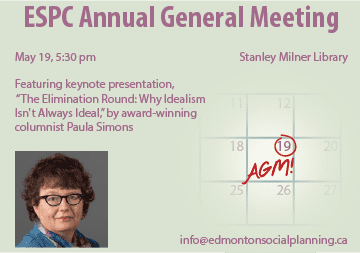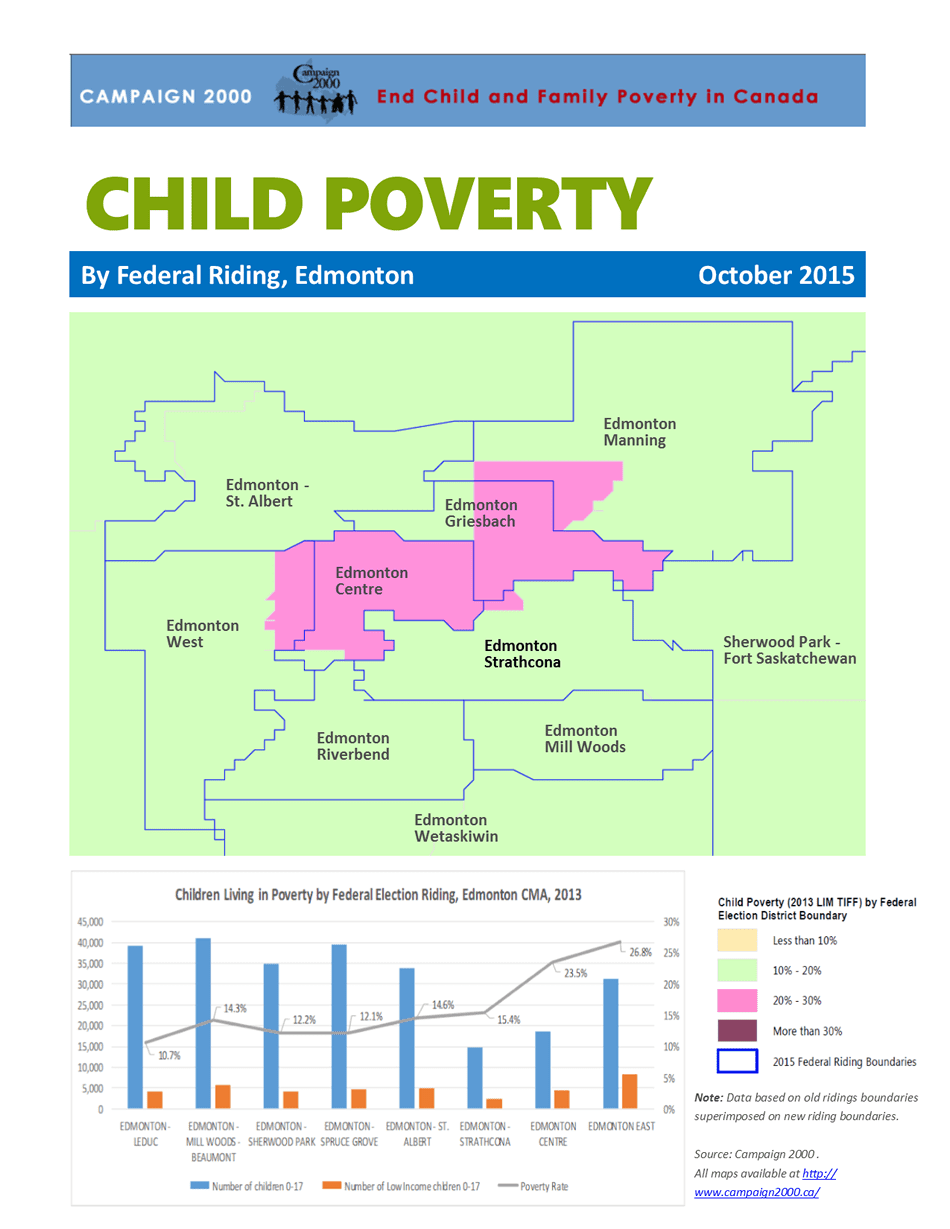ESPC releases updated publication tracking trends – Click here to download – 2015 ESPC Tracking the Trends
The Edmonton Social Planning Council (ESPC) today released the 2015 edition of its flagship publication Tracking the Trends. The 128-page publication provides a detailed analysis of social and economic trends in Edmonton. Information is provided about population demographics, education and employment, living costs & housing, income & wealth, and poverty trends that together comprise the social health of Edmontonians.
“Whether planning programs or developing policies, timely accurate information is critical to informed decision-making,” said John Kolkman, the ESPC’s Research Coordinator. “Tracking the Trends is a one-stop resource for identifying and analyzing a broad range of social and economic trends impacting those with low and modest incomes in our community,” he added.
“An overarching message in this year’s Tracking the Trends is that – following several years of strong employment and income growth – Edmonton is entering a period of increased uncertainty due to a collapse in oil and natural gas prices. The impact of this change is starting to show up in some of the trends we follow,” noted Kolkman.
Kolkman highlighted several key Edmonton trends reflecting this uncertainty:
- Job growth has leveled off so far in 2015, following several years of strong growth (p. 21);
- The number of people receiving Employment Insurance regular benefits is up 55.1% in the first eight months of 2015, compared to the level in 2014 (p. 79);
- A 9.1% increase in the number of Edmonton households receiving Alberta Works (social assistance) benefits in the first nine months of 2015, compared to the 2014 average (p. 77);
- 14,794 individuals were served by Edmonton’s Food Bank in March 2015, up 15.4% compared to a year earlier (p. 37);
- At 4.2% in October 2015, the rental vacancy rate is up significantly, meaning increased availability. Rents are still up 2.2% from a year earlier to $1,259 per month for a two-bedroom unit (p. 32).
Tracking the Trends 2015 also identifies a number of concerning trends:
- 128,810 people in metro Edmonton lived in poverty in 2013, 10.5% of the population. 41,640 were children and youth under 18, 15.2% of all children and youth (pp. 72, 74);
- While median family incomes are up overall, much of this increase has gone to the highest income earners. Since 1982, the top 1% of Edmonton taxfilers have seen their after-tax incomes, after accounting for inflation, go up by 53.4% compared to only a 5.9% increase for the bottom 50% of taxfilers (p. 52);
- There continues to be a significant income gap based on gender. In 2013, female taxfilers median total income was $31,460 compared to $55,060 for male taxfilers (p. 46).
- In 2011, 59.2% of poor children lived in families where at least one parent works full-time for the full-year. A job is not necessarily a ticket out of poverty (p. 70); and
- There was a 6.2% increase in homelessness between October 2012 and October 2014. There is also a trend toward an increased number of youth experiencing homelessness (p. 36). The number of homeless people is still down 25.1% from its October 2008 peak.
Kolkman said the report also finds many positive trends:
- The steady improvement in educational attainment as measured by high school completion and post-secondary attainment continues. However, almost one in five young adults fails to complete high school within five years showing room for further improvement (p. 27);
- Compared to other Canadian urban centres, Edmonton has a relatively young population with a median age of 35.9 (p. 4). This sets the stage for more people making an economic contribution in the future;
- Government income transfers lifted 53,960 Alberta children and youth above the poverty line in 2013 (p. 67);
- Aboriginals 15 years and older earn a slightly higher percentage of their income from employment (82%) compared to the total Edmonton population (81%) (p. 50); and
- Reductions in the number of Edmonton children in government care due to a focus on supporting children in their birth families (p. 94); and
- Employment earnings provide the main source of income for all family types including lone parents (p. 48).
Tracking the Trends 2015 combines 22 key indicators grouped into 5 categories into a Social Health Index (pp. 106-111). Categories where Edmonton does well are financial security and personal & family stability. Edmonton is doing more poorly on population health and participation & environmental indicators.
“The bottom line is a 20.1% improvement in Edmonton’s social health since the year 2000. During this time period, Edmonton’s social health improved at a more rapid rate than the 14.5% growth in Alberta GDP per person,” Kolkman concluded.
 In September 2015, the EndPovertyEdmonton Task Force released its Strategy with a bold goal of ending poverty within a generation. [The] Strategy was robustly tested with thousands of Edmontonians who told us our community is more than ready to join us in the epic work to end poverty in a generation.
In September 2015, the EndPovertyEdmonton Task Force released its Strategy with a bold goal of ending poverty within a generation. [The] Strategy was robustly tested with thousands of Edmontonians who told us our community is more than ready to join us in the epic work to end poverty in a generation. Please join the Board and staff of the Edmonton Social Planning Council on May 19th to celebrate our accomplishments of the past year and to hear about upcoming activities of the Council.
Please join the Board and staff of the Edmonton Social Planning Council on May 19th to celebrate our accomplishments of the past year and to hear about upcoming activities of the Council.